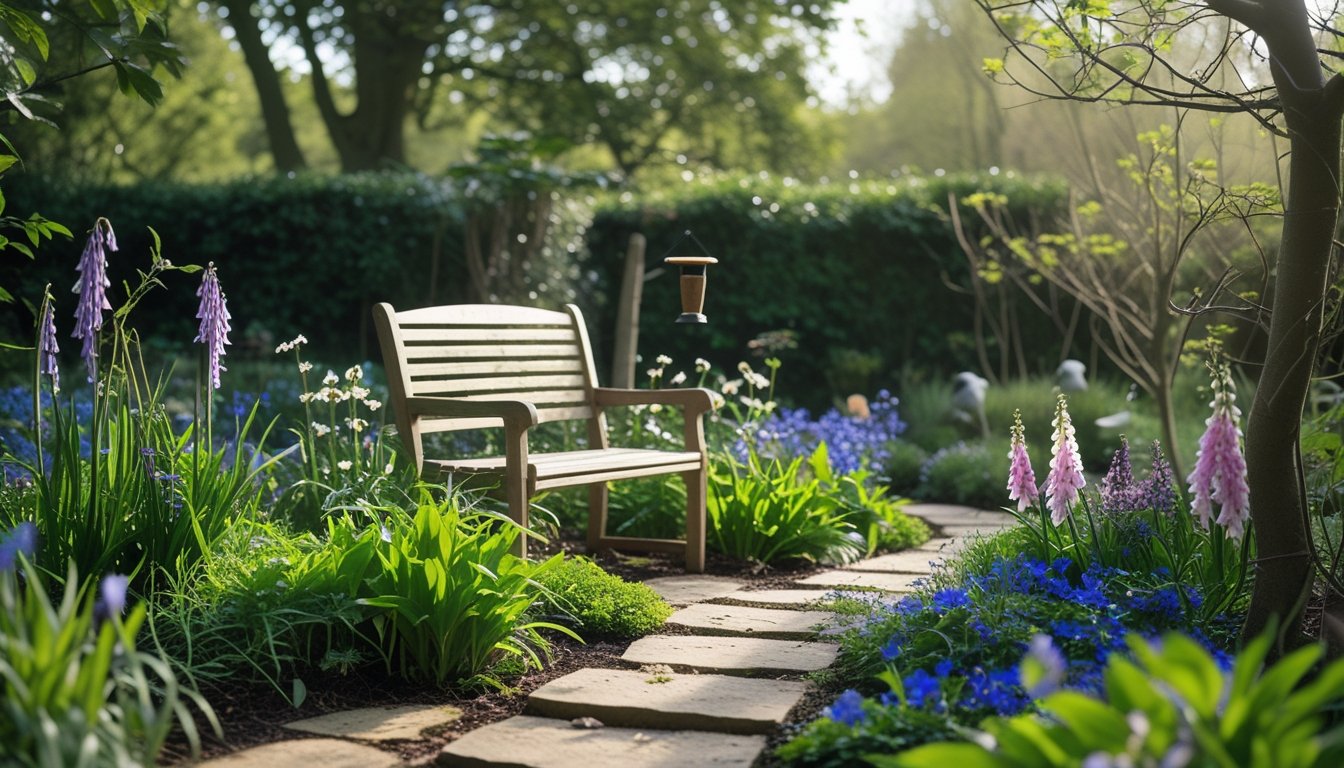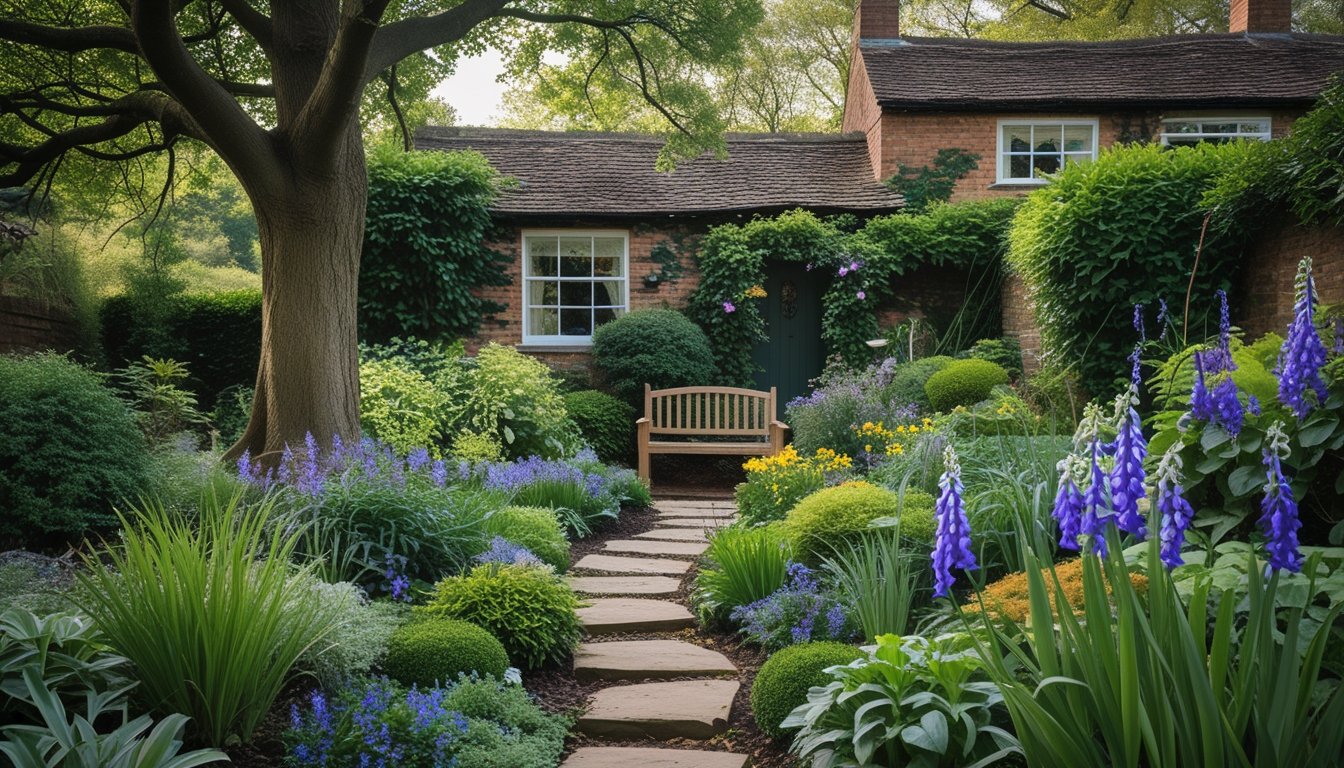Late updated: 05 Nov 2025 13:11
Written by: James Whitaker
Creating A Tranquil UK Garden With Native Plants: An Expert's Guide
In the hustle and bustle of our modern lives, creating a tranquil garden sanctuary can be an ideal way to unwind and connect with nature. When planning a UK garden, native plants are an excellent choice as they are perfectly adapted to the local climate and soil conditions. Cultivating native plants not only simplifies garden maintenance but also supports local wildlife, enhancing biodiversity right in our backyards.

Native plant gardens are not just eco-friendly; they also bring a unique charm and beauty that is deeply rooted in our natural heritage. By incorporating elements like oak and silver birch, along with shrubs such as hazel and holly, we can create layered garden features that form peaceful retreats. These plants, familiar to the local ecosystem, provide essential habitats and food sources for pollinators and other wildlife, making them invaluable in sustaining ecological balance.
As we explore the art of creating a tranquil UK garden, it becomes clear that thoughtful plant selection plays a pivotal role. By choosing native flora, we can craft a serene outdoor space that resonates with natural harmony while reducing the need for artificial interventions. Our journey into native plant gardening promises to reveal the beauty and benefits of embracing the landscape that surrounds us.
Key Takeaways
- Choose native plants to simplify garden maintenance.
- Employ native flora to sustain local wildlife.
- Create layered features for a tranquil garden retreat.
Principles Of Creating A Tranquil UK Garden With Native Plants

Creating a tranquil garden in the UK using native plants involves understanding their benefits, how they interact with local ecosystems, selecting the right species, and prioritising soil and water conditions. These elements contribute to a garden that is harmonious and supportive of both our well-being and the environment.
Benefits Of Using Native Plants For Tranquillity
Native plants are well adapted to local climates, making them low-maintenance options for any UK garden. They support tranquillity by fostering local wildlife, which enriches the sensory experience. Native flora also tends to be more resilient to pests, reducing the need for chemical interventions. Moreover, their growth patterns contribute to a natural aesthetic that promotes relaxation and peace.
Incorporating native plants enhances biodiversity, as these plants nurture indigenous insects and birds. This interconnectedness with local fauna creates a living, breathing ecosystem. Through the seasonal changes they exhibit, native plants also connect us with the subtleties of the natural cycles, providing a soothing rhythm in our own green spaces.
Understanding Local Ecosystems And Biodiversity
Local ecosystems are delicately balanced, with each species playing a crucial role. When we integrate native plants, we support these intricate networks. This approach ensures that our gardens do not disrupt existing wildlife but instead offer additional benefits. Understanding the relationships between soil, plants, and animals in our specific area allows us to create gardens that are extensions of their natural surroundings.
Native plants encourage biodiversity by offering habitats and food for local species. For example, wildflowers attract pollinators necessary for both garden prosperity and broader ecosystem health. Recognising how native plants work with other organisms helps reinforce the natural heritage, ensuring these ecosystems remain stable and productive.
Selecting Native Species Suited To Your Garden
Choosing the right native species depends on various factors, including the garden’s size and sunlight exposure. It’s important to select plants that naturally thrive in your particular area, ensuring they contribute effectively to your garden’s tranquillity. Each plant must complement the garden’s layout, while meeting practical considerations like maintenance requirements and growth habits.
A mix of shrubs, perennials, and grasses can be particularly effective. Species such as oak trees provide structure, while foxgloves offer colour and attract helpful pollinators. Incorporating a diversity of plant types will create visual interest and ecological stability, enhancing both beauty and functionality.
Prioritising Soil Conditions And Water Sources
Soil health is integral to the success of native plants. Before planting, it's crucial to assess the soil type, drainage capacity, and nutrient levels. Native species usually thrive in local soil types, yet ensuring optimal soil conditions through organic amendments can promote more robust growth.
Water management is also essential. Native plants often have evolved to withstand local rainfall patterns, reducing the need for irrigation. Nonetheless, in areas prone to drought, selecting drought-resistant native plants ensures gardens remain lush without excessive water usage. Implementing rainwater harvesting or efficient irrigation systems can further align the garden’s water needs with environmental sustainability. Their deep-root systems can help manage excess water by improving soil permeability, protecting both plants and the surrounding environment during heavy rains.
Enhancing Relaxation And Supporting Wildlife With Native Plants

Creating a tranquil garden with native plants in the UK not only offers a peaceful retreat but also provides vital support for local wildlife. Integrating grasses, ivy, and wildflowers adds texture, while attracting pollinators such as bees, butterflies, and birds enriches biodiversity. Moreover, thoughtful design ensures year-round interest and habitat creation.
Utilising Grasses, Ivy, And Wildflowers For Texture
Native grasses like Festuca or Deschampsia introduce gentle movement and soft sounds to our garden. These elements enhance a calming atmosphere. Ivy can cover walls or fences, providing a lush backdrop and essential shelter for small creatures.
Wildflowers like poppies and cornflowers give vibrant color contrasts and attract beneficial insects. Planting these encourages biodiversity, supporting an array of wildlife, all while creating varied textures and layers that contribute to a serene garden environment.
Attracting Pollinators: Bees, Butterflies, And Birds
Nectar-rich plants such as lavender and foxglove serve as magnets for bees and butterflies. By including these, we ensure pollinators become regular visitors, enhancing the garden's vitality.
Birds benefit from berries and seeds from plants like hawthorn and crab apple. These attract insects, providing additional food sources. As we incorporate these native species, we support a self-sustaining ecosystem that thrives naturally, adding life and movement to our garden.
Designing For Year-Round Interest And Habitat Creation
To maintain interest through all seasons, we can use a variety of plants that bloom at different times or have appealing foliage. Evergreen plants, like holly and ivy, provide structure and year-round greenery, ensuring the garden remains a soothing escape even in winter.
Deadwood and leaf piles add to habitat creation, offering shelter for insects and nesting sites for birds. By considering the lifecycle of plants and animals in our design, we promote an environment that caters to wildlife throughout the year, creating a dynamic and tranquil space that continuously evolves.
Frequently Asked Questions

Creating a tranquil garden using native UK plants involves selecting species that attract local wildlife, designing layouts that evoke calm, and ensuring year-round colour. We need to consider soil and climate conditions and employ specific planting strategies to maintain a healthy ecosystem.
What are the best native plant species for attracting wildlife in a UK garden?
Native plants like wildflowers are excellent for encouraging wildlife. Bluebells, primroses, and foxgloves provide food and habitat for pollinators such as bees and butterflies. Hedgerows of hazel or hawthorn offer shelter and food for birds and small mammals, boosting biodiversity in our garden spaces.
How can one design a garden layout that promotes tranquillity using British native plants?
To create a calming atmosphere, we should incorporate winding pathways and seating areas surrounded by lush plantings of ferns and grasses. The gentle rustling of leaves from willow trees or birches adds a sense of serenity. Planting in layers, from ground covers to taller species, fosters a peaceful environment.
Which native flowering plants should be included for year-round colour in a UK garden?
To ensure vibrant colours throughout the year, we can plant snowdrops and hellebores for winter, followed by daffodils and forget-me-nots in spring. Summer sees the bloom of campanula and red valerian. Autumn interest comes from plants like michaelmas daisies and crab apples, keeping our garden colourful across all seasons.
What considerations should be taken into account for soil and climate when selecting UK native plants for a garden?
Understanding the specific type of soil—whether it's clay, chalky, or sandy—is critical for plant selection. We also need to factor in the garden's microclimate, such as exposure to wind and frost. By matching plants to suitable environmental conditions, we improve their growth and vitality.
How can you maintain a healthy garden ecosystem with indigenous UK plant varieties?
Using compost and mulch enhances soil health and nutrient levels. Minimising chemical fertilisers and pesticides encourages the presence of beneficial insects. By creating varied habitats with logs or ponds, we support diverse life forms, ensuring that our garden thrives naturally and sustainably.
What are effective planting strategies for creating privacy with native shrubs and trees in a UK garden?
Planting dense hedgerows of beech, yew, or holly offers natural privacy and decreased noise pollution. Layering shrubs like hazel beneath taller trees creates additional screening. These native species not only provide seclusion but also serve as wildlife corridors, enriching our garden's ecological value.
